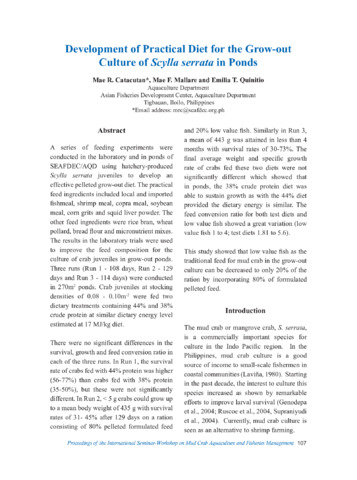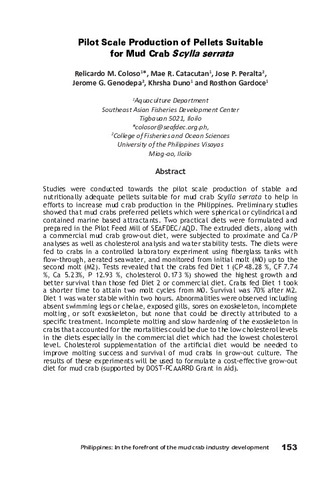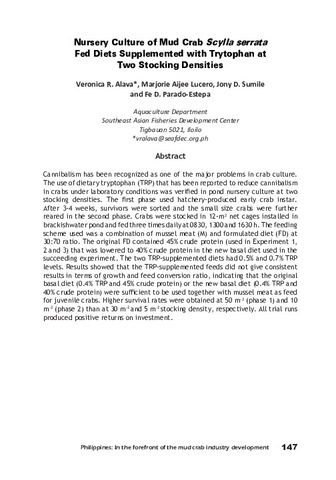| dc.contributor.author | Millamena, Oseni M. | |
| dc.contributor.author | Quinitio, Emilia | |
| dc.date.accessioned | 2014-01-13T03:15:55Z | |
| dc.date.available | 2014-01-13T03:15:55Z | |
| dc.date.issued | 2000 | |
| dc.identifier.citation | Millamena, O. M., & Quinitio, E. (2000). The effects of diets on reproductive performance of eyestalk ablated and intact mud crab Scylla serrata. Aquaculture, 181(1-2), 81-90. | en |
| dc.identifier.issn | 0044-8486 | |
| dc.identifier.uri | http://hdl.handle.net/10862/1877 | |
| dc.description.abstract | The reproductive performance of female mud crabs was evaluated as affected by various diets. Dietary treatments were as follows: D1 — natural diet (mussel meat, squid, trash fish); D2 — combination of natural and formulated diets; D3 — formulated diet. Pond-sourced broodstock, with initial body weight of 300–400 g, were tagged in their carapace then stocked in three units of 10 m3 broodstock tanks at eight females per tank. Half of the females were ablated and the other half were intact. Spawnings were monitored and berried females were transferred to individual 500-l tanks for incubation of eggs. Four experimental runs were conducted. Broodstock response in terms of number of spawnings, spawnings with hatching, fecundity, egg fertilization rate, total zoea produced and broodstock survival was enhanced in females fed the mixed diet (D2) compared to those fed the natural diet (D1) or the formulated diet (D3). Larval quality measured as larval stage index followed the same trend. Results further showed that intact females fed diets D1 and D2 gave higher numerical values in reproductive performance and zoea growth index than ablated females while ablated females fed diet D3 performed better than their intact counterparts. This may be attributed to presence of essential nutrients and vitamins A, C, E in the formulated diet. Latent period from gonadal maturation to first spawning was shortened by eyestalk ablation. Use of a combined diet would ensure the production of good quality eggs and large numbers of zoea with the best chance of completing the larval stages and thus, would serve as an appropriate starting point in establishing a viable mud crab aquaculture. | en |
| dc.description.sponsorship | This project was a collaborative research between the Australian Center for International Agricultural Research ( ACIAR) and the Aquaculture Department of the Southeast Asian Fisheries Development Center (SEAFDEC) under ACIAR Project No. 9217. The authors acknowledge with gratitude the efforts of Mr. David Mann of Bribie Is. Aquaculture Research Center in Brisbane, Australia for showing us the broodstock management techniques; the assistance of Josette Bangcaya, Danilo Javellana and Cezar Tabigo-on in the conduct of the experiments; Mr. Roman Sanares, in the statistical analysis of data; the Centralized Analytical Laboratory staff, in proximate and water analyses; and the Feed Mill laboratory staff, in broodstock diet preparation; both of the SEAFDEC Aquaculture Department. | en |
| dc.language.iso | en | en |
| dc.publisher | Elsevier | en |
| dc.subject | Scylla serrata | en |
| dc.subject | Broodstock diet | en |
| dc.subject | reproductive performance | en |
| dc.title | The effects of diets on reproductive performance of eyestalk ablated and intact mud crab Scylla serrata | en |
| dc.type | Article | en |
| dc.citation.volume | 181 | |
| dc.citation.issue | 1-2 | |
| dc.citation.spage | 81 | |
| dc.citation.epage | 90 | |
| dc.citation.journalTitle | Aquaculture | en |
| dc.subject.asfa | aquaculture techniques | en |
| dc.subject.asfa | crab culture | en |
| dc.subject.asfa | diet | en |
| dc.subject.asfa | eyestalk extirpation | en |
| dc.subject.asfa | fecundity | en |
| dc.subject.asfa | feeding experiments | en |
| dc.identifier.doi | 10.1016/S0044-8486(99)00214-8 | |
| dc.subject.scientificName | Scylla serrata | en |



